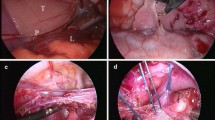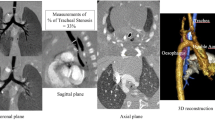Abstract
Purpose
Tracheomalacia (TM) is a frequent complication after esophageal atresia (EA) repair. This study aimed to review patients who underwent aortopexy for TM after EA repair and to compare their imaging features.
Methods
The patients who underwent thoracoscopic EA repair and contrast-enhanced computed tomography (CECT) at our hospital between 2013 and 2020 were retrospectively reviewed. The ratio of the lateral and anterior–posterior diameter of the trachea (LAR) where the brachiocephalic artery (BCA) crosses the trachea was defined. The LAR of the patients who underwent CECT for asymptomatic pulmonary disease was set as a normal reference. The Z-score of each LAR was calculated and compared between the patients that did or did not undergo aortopexy.
Results
A total of 51 patients represented the controls, 5 patients underwent aortopexy, and 12 patients were discharged without surgery. The mean LARs in the patients who underwent aortopexy, did not undergo aortopexy, and controls were 3.54, 1.54, and 1.15, respectively. The mean Z-score of the aortopexy group was 21.2. After successful aortopexy, each patient’s LAR decreased to < 1.5.
Conclusion
Aortopexy was preferred if the trachea was compressed by the BCA. The LAR is a useful indicator for predicting the therapeutic effect of aortopexy.




Similar content being viewed by others
References
Nassar N, Leoncini E, Amar E, Arteaga-Vazquez J, Bakker MK, Bower C, Canfield MA et al (2012) Prevalence of esophageal atresia among 18 international birth defects surveillance programs. Birth Defects Res A Clin Mol Teratol 94:893–899
Quiroz HJ, Turpin A, Willobee BA, Ferrantella A, Parreco J, Lasko D, Perez EA, Sola JE, Thorson CM (2020) Nationwide analysis of mortality and hospital readmissions in esophageal atresia. J Pediatr Surg 55:824–829
Masuya R, Kaji T, Mukai M, Nakame K, Kawano T, Machigashira S, Yamada W, Yamada K, Onishi S, Yano K, Moriguchi T, Sugita K, Kawano M, Noguchi H, Suzuhigashi M, Muto M, Ieiri S (2018) Predictive factors affecting the prognosis and late complications of 73 consecutive cases of esophageal atresia at 2 centers. Pediatr Surg Int 34:1027–1033
Rayyan M, Embrechts M, Van Veer H, Aerts R, Hoffman I, Proesmans M, Allegaert K, Naulaers G, Rommel N (2019) Neonatal factors predictive for respiratory and gastro-intestinal morbidity after esophageal atresia repair. Pediatr Neonatol 60:261–269
Fraga JC, Jennings RW, Kim PC (2016) Pediatric tracheomalacia. Semin Pediatr Surg 25:156–164
Snijders D, Barbato A (2015) An update on diagnosis of tracheomalacia in children. Eur J Pediatr Surg 25:333–335
Hysinger EB, Panitch HB (2016) Paediatric tracheomalacia. Paediatr Respir Rev 17:9–15
Overman AE, Liu M, Kurachek SC, Shreve MR, Maynard RC, Mammel MC, Moore BM (2013) Tracheostomy for infants requiring prolonged mechanical ventilation: 10 years’ experience. Pediatrics 131:e1491-1496
Gross RE, Neuhauser EB (1948) Compression of the trachea by an anomalous innominate artery; an operation for its relief. Am J Dis Child 75:570–574
Engum SA, Grosfeld JL, West KW, Rescorla FJ, Scherer LR 3rd (1995) Analysis of morbidity and mortality in 227 cases of esophageal atresia and/or tracheoesophageal fistula over two decades. Arch Surg 130:502–508 (discussion 508-509)
DeBoer EM, Prager JD, Ruiz AG, Jensen EL, Deterding RR, Friedlander JA, Soden J (2016) Multidisciplinary care of children with repaired esophageal atresia and tracheoesophageal fistula. Pediatr Pulmonol 51:576–581
Watters KF (2017) Tracheostomy in Infants and Children. Respir Care 62:799–825
Torre M, Carlucci M, Speggiorin S, Elliott MJ (2012) Aortopexy for the treatment of tracheomalacia in children: review of the literature. Ital J Pediatr 38:62
Author information
Authors and Affiliations
Corresponding author
Additional information
Publisher's Note
Springer Nature remains neutral with regard to jurisdictional claims in published maps and institutional affiliations.
Rights and permissions
About this article
Cite this article
Sumida, W., Tainaka, T., Shirota, C. et al. An imaging study on tracheomalacia in infants with esophageal atresia: the degree of tracheal compression by the brachiocephalic artery is a good indicator for therapeutic intervention. Pediatr Surg Int 37, 1719–1724 (2021). https://doi.org/10.1007/s00383-021-04985-0
Accepted:
Published:
Issue Date:
DOI: https://doi.org/10.1007/s00383-021-04985-0




